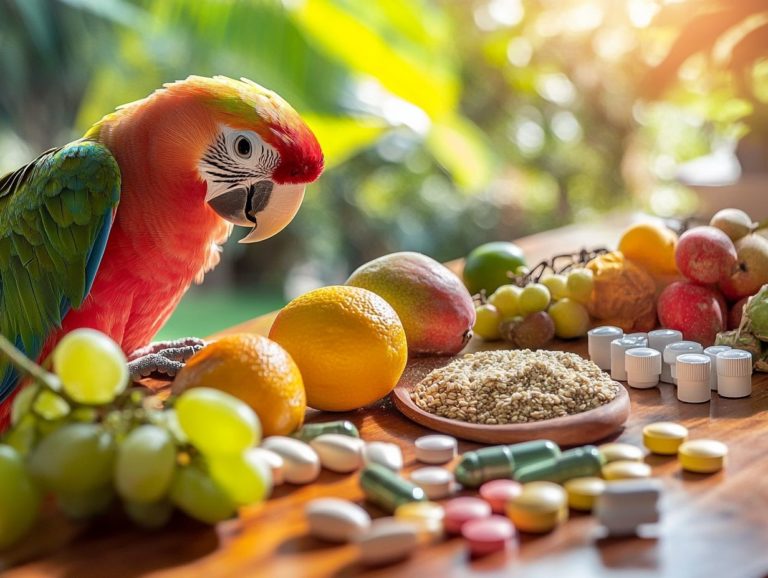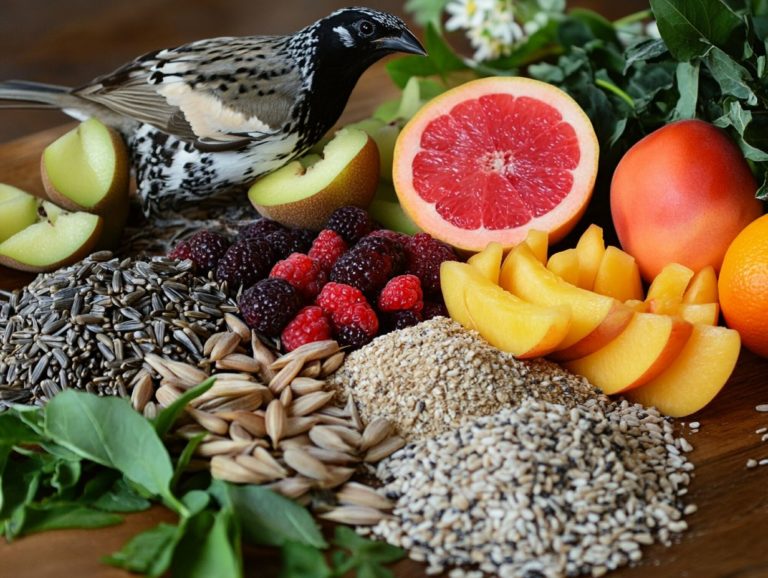Feeding Baby Birds: A Complete Guide
Feeding baby birds is a delicate yet rewarding endeavor that requires a keen understanding of their unique nutritional needs, especially considering the various species.
Selecting the right types of food for their growth and determining the appropriate frequency of feedings are crucial steps. This guide explores various feeding techniques, including hand-feeding and tube-feeding, while also highlighting common mistakes to avoid.
It underscores the importance of proper supplementation and addresses how to care for injured or orphaned birds.
Join us on this journey to help your feathered friends thrive!
Contents
Key Takeaways:
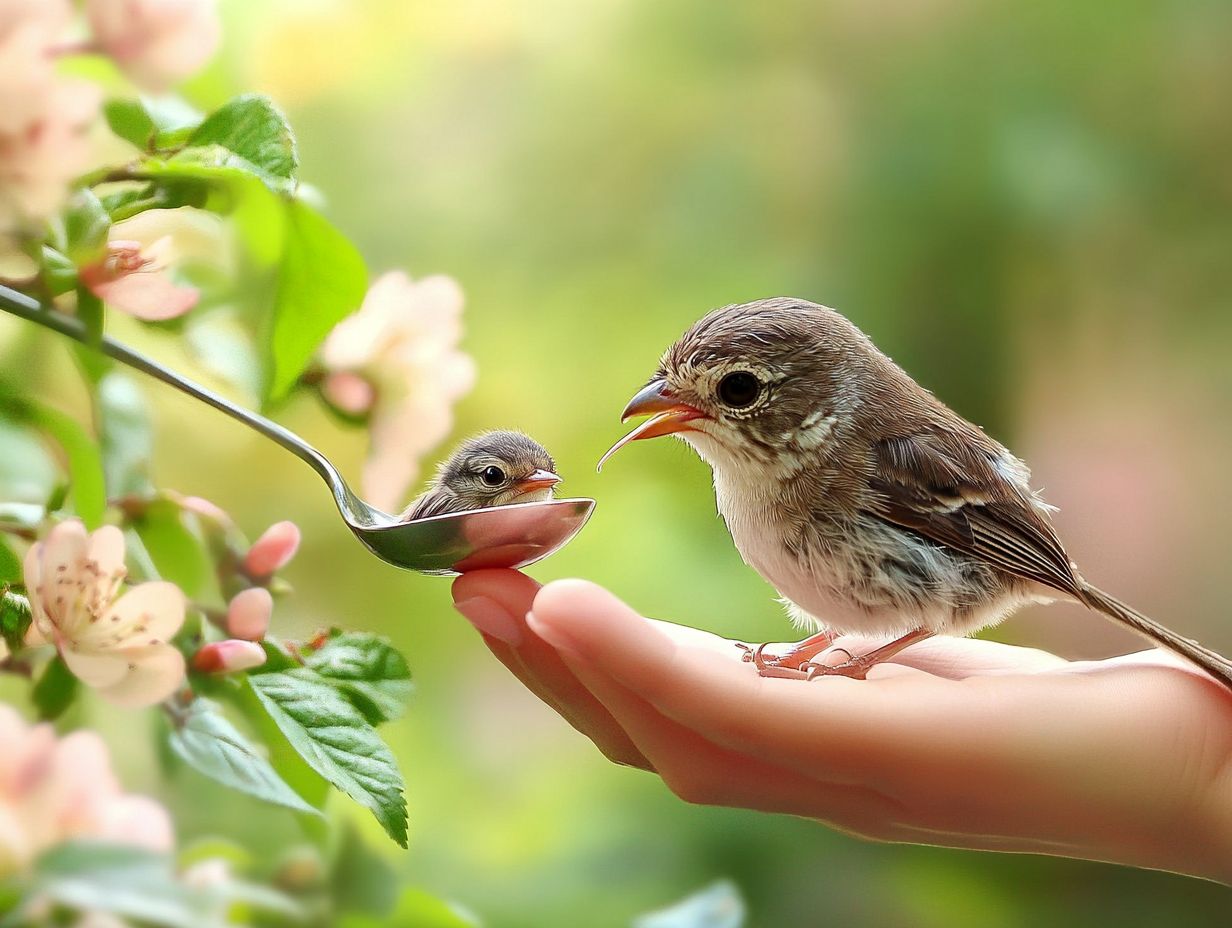
- Learn what baby birds eat to provide them with a balanced and healthy diet.
- Understand proper feeding techniques, such as hand-feeding with a syringe or tube-feeding, to ensure baby birds’ safety and well-being.
- Avoid common mistakes, like improper nutrition and lack of supplementation, to prevent health issues in baby birds.
Understanding Baby Birds’ Nutritional Needs
Understanding the nutritional needs of baby birds is crucial for their growth and survival. Each species has distinct dietary requirements and preferences, particularly during the nestling and fledgling stages.
Young birds, from house sparrows to finches and hummingbirds, depend on specific nutrients to flourish during critical developmental stages. They require careful monitoring to ensure they receive the right baby bird food.
As a wildlife rehabilitator, you should be well-versed in the correct diet for baby birds to promote optimal health and effectively monitor their well-being. This helps prevent complications like crop stasis, which means food is not moving through a baby bird’s digestive system as it should, through proper nutrition and emergency feeding when necessary.
Types of Food Baby Birds Need
Baby birds require a diverse array of food types to meet their specific nutritional needs. This includes commercial baby bird food, soft fruits, and tailored homemade recipes designed for their species.
Essential nutrients like proteins, fats, and vitamins are vital for supporting their growth and development. It’s important to consider the unique feeding frequency for different baby bird species.
Understanding the dietary preferences of various species is key to their well-being. For example, granivores, such as house sparrows, thrive on seeds and grains, while insectivores, like blue jays, significantly benefit from protein-rich insects and larvae.
When preparing food for these young birds, finely chop or puree options like soft fruits and vegetables. This ensures they can consume and digest them easily while also being mindful of their feeding schedule.
Many commercial baby bird foods, including species-specific varieties, offer balanced nutrition, making them an excellent supplementary option. By combining commercial foods with your homemade meals and proper vitamin supplementation, you can ensure that baby birds receive the essential nutrients they need for robust health and growth.
Frequency and Amount of Feedings
The frequency and amount of feedings are crucial for baby birds’ growth and development. Specific guidelines are tailored to each species and their unique needs. Typically, baby birds require more frequent feedings than their adult counterparts to support their rapid growth, especially during the nestling and fledgling stages.
If you’re caring for smaller species like finches, you might need to feed them every 15 to 30 minutes. In contrast, larger breeds, such as parrots, may thrive on a schedule of every 2 to 4 hours. The recommended feeding amounts can also vary; younger chicks, like finches, generally need about 10% of their body weight in food daily, while older nestlings may do well with less frequent but more substantial meals.
Keep in mind that factors such as temperature, activity level, and individual health conditions can influence how often you should feed baby birds. Observing these needs closely allows you to adjust the feeding schedule, ensuring optimal growth and health for your feathered companions while minimizing health risks.
Feeding Techniques for Baby Birds
Feeding techniques for baby birds are vital for their survival and can vary greatly depending on the bird’s age, species, and individual requirements. Additionally, understanding bird adoption can help you choose the best methods for care by providing insights into their needs.
When caring for orphaned or injured birds, hand-feeding with a feeding syringe or tube-feeding using a commercial hand-rearing formula is often preferred by wildlife rehabilitators. These methods help birds get the proper nutrition and hydration they need to thrive, especially when warm food is used to facilitate feeding.
Hand-Feeding vs. Tube-Feeding
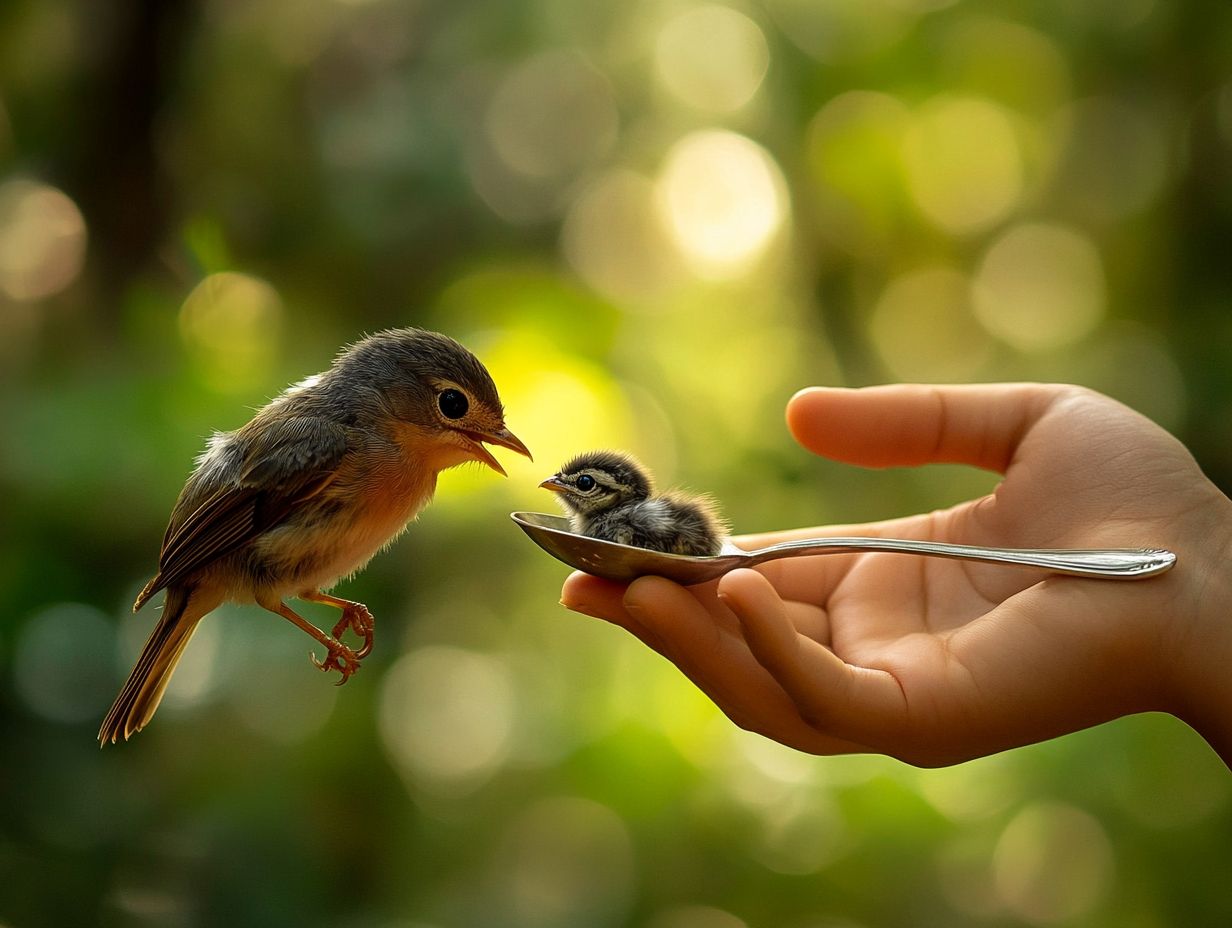
Both hand-feeding and tube-feeding are effective methods for nourishing baby birds, each with distinct advantages for different situations. Hand-feeding allows for closer interaction, helping you bond with the bird while providing necessary nourishment, which is crucial for their welfare.
Tube-feeding ensures the baby bird receives a precise amount of food quickly and efficiently, especially when you notice specific signs of distress. Hand-feeding is often your best choice when emotional bonding and stimulation are key for healthy growth. It creates a nurturing environment that can help build trust and reduce stress in the young bird.
When you choose hand-feeding, use a specialized feeding syringe, ensuring the formula is heated to the right temperature and has a smooth consistency for easy consumption. Tube-feeding requires the right-sized tube for the bird’s age and a properly prepared formula tailored to their nutritional needs.
Understanding both methods helps you choose the right one for each baby bird, ensuring they receive the care they need for their growth.
Common Mistakes in Feeding Baby Birds
Common mistakes in feeding baby birds can really harm their health, leading to issues like improper nutrition and conditions like crop stasis, where food doesn’t move from the bird’s stomach, which can be dangerous.
Many caregivers might not fully understand the specific dietary requirements of different baby bird species or the potential dangers associated with certain foods. It’s essential to follow established feeding precautions and consult a resource like how to handle a sick bird regarding feeding frequency and amounts to ensure their well-being.
Issues with Improper Nutrition
Improper nutrition in baby birds poses significant health risks. It profoundly impacts their growth and overall welfare, including potential malnutrition and developmental issues. By providing incorrect feeding amounts or unsuitable food types, you may inadvertently cause malnutrition and developmental issues, such as stunted growth and poor feather development.
For instance, a deficiency in calcium can weaken their bones, making them more susceptible to fractures. Insufficient vitamin A can compromise their immune function and lead to vision problems. This highlights the importance of bird nutrition. Overfeeding baby birds seeds, which are typically high in fat and low in essential nutrients, can lead to obesity and complications like fatty liver disease. Proper baby bird diet management is crucial.
The effects of these dietary missteps are particularly noticeable in fledglings. They rely heavily on nutrient-rich diets for proper development and healthy growth. By closely observing their behaviors and growth patterns, including signs of help, you can often determine whether they are receiving the balanced nutrition essential for thriving.
Supplementing with Vitamins and Minerals
Supplementing baby birds with essential vitamins and minerals, such as those found in commercial baby bird food, is vital for their development. This is especially important when their primary diet may fall short in specific nutrients.
By providing proper supplementation, including species-specific food options, you can ensure that these young birds get the balanced nutrition necessary for them to thrive.
Importance of Proper Supplementation
Proper supplementation of vitamins and minerals is crucial in supporting the growth of your baby bird. It can prevent a host of developmental issues, particularly in their early stages of life. Understanding the specific nutritional needs of different species is key to effective care. This allows you to tailor feeding methods to meet their unique requirements.
For instance, calcium is essential for bone development, particularly in species like cockatiels and budgerigars. Vitamin A is vital for vision and immune function across various breeds. This highlights the importance of consulting an avian veterinarian. You can easily assess how well your baby bird is doing by observing its weight, plumage quality, and overall activity levels. If you notice lethargy or poor feathering, this could mean your baby bird needs immediate help!
To ensure proper supplementation, it s wise to consult a veterinarian who specializes in avian health. They can provide guidance on appropriate feeding methods and dietary needs. Consider using species-specific formulas or supplements and be diligent in following dosage instructions to avoid any risk of toxicity. This ensures you provide safe and effective baby bird care. By regularly monitoring and adjusting the diet, you can significantly enhance your baby bird’s chances of thriving during its formative stages, ensuring they receive the proper nutrition needed for their growth.
Feeding Baby Birds with Special Needs
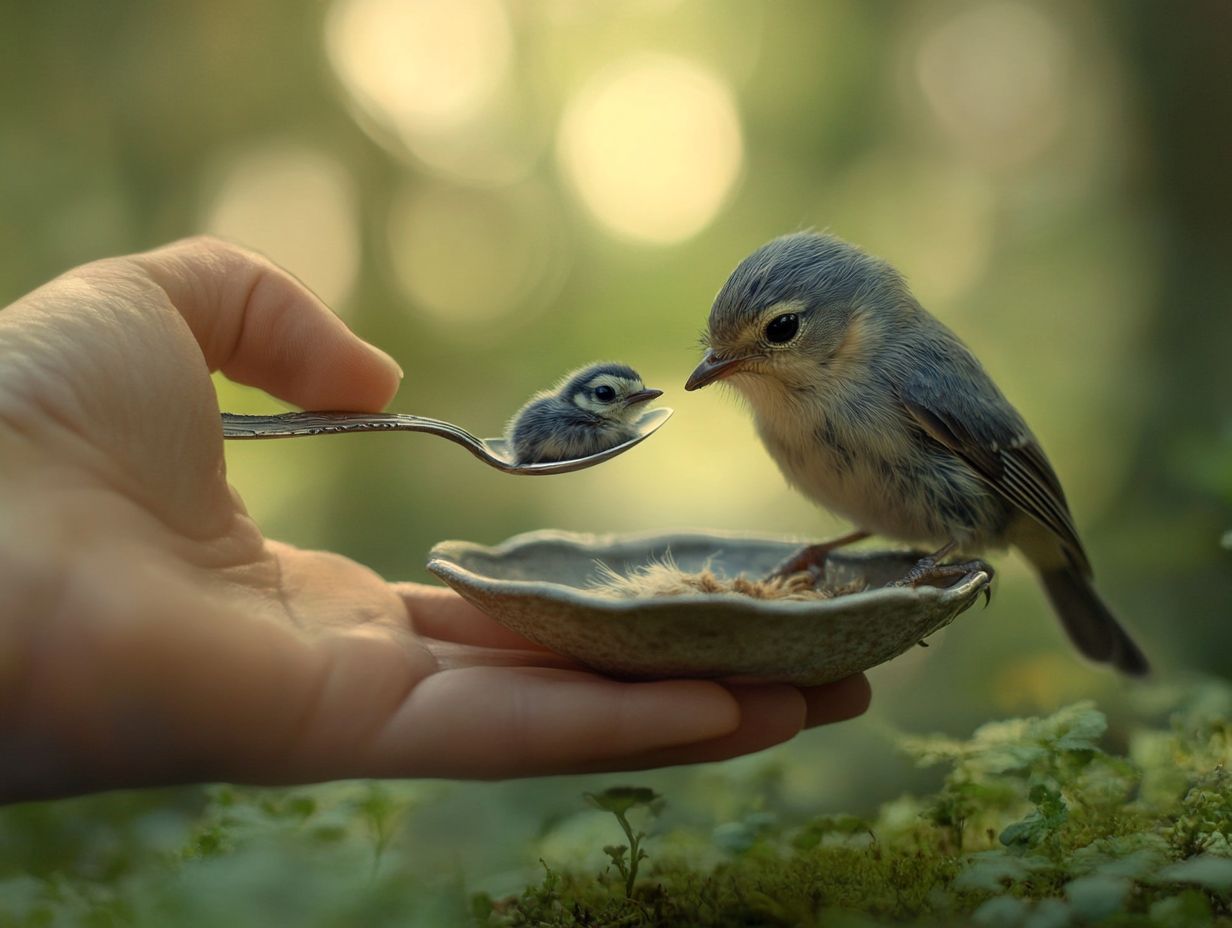
Caring for baby birds with special needs demands a bespoke approach and vigilant oversight to effectively tackle their unique challenges. This is particularly important when it comes to feeding techniques and emergency feeding situations.
Whether you find yourself nurturing injured, ill, or orphaned birds, employing specialized feeding tools, such as a feeding syringe, can dramatically improve their chances of recovery. Use techniques that cater to their specific needs. Act swiftly to ensure these little ones get the care they need!
Essential Feeding Techniques for Injured or Sick Birds
When caring for injured or sick birds, your feeding techniques should prioritize gentleness and precision. This ensures that you do not worsen their condition while providing necessary nourishment.
Their weakened state demands careful handling to minimize added stress. It s crucial to ensure the food is at the proper temperature to aid in their recovery.
Effective health monitoring during feeding is essential. This helps ensure they receive adequate nutrition and that any signs of distress are promptly addressed for optimal recovery.
To facilitate their recovery, consider using specialized feeding tools like syringes or dropper bottles that allow for controlled flow. Watch closely! The bird s response can tell you a lot about how it s feeling.
If the bird struggles or shows distress, try adjusting the feeding position or modifying the consistency of the food. These small changes can make a notable difference.
Regularly weighing the bird provides valuable insights into their progress. This helps you determine if any adjustments to the feeding regimen are necessary.
Pay close attention to the droppings as they serve as a vital health indicator. This reveals whether the diet is appropriate and if the bird is improving or declining.
Feeding Techniques for Orphaned Birds
Feeding techniques for orphaned birds involve replicating the care they would have received from their parents. This is vital for their survival and development.
Establishing a consistent feeding schedule is critical to maintaining their health during this vulnerable time. You can develop a routine that closely mirrors the natural feeding intervals typical for their species.
Generally, baby birds need to be fed every 15 to 30 minutes during daylight hours to thrive.
Using a mixture of special baby bird food or softened, high-protein foods will effectively mimic the nutritious diet they would naturally enjoy. Monitor each bird s growth and behavior by observing their weight and responsiveness.
Providing a warm environment free from drafts significantly enhances their chances of survival during this crucial early stage.
Frequently Asked Questions
What type of food should I feed baby birds?
When feeding baby birds, mimic their natural diet as much as possible. Offer a variety of insects, fruits, and seeds. You can also purchase specialized baby bird formula from your local pet store.
How often should I feed baby birds?
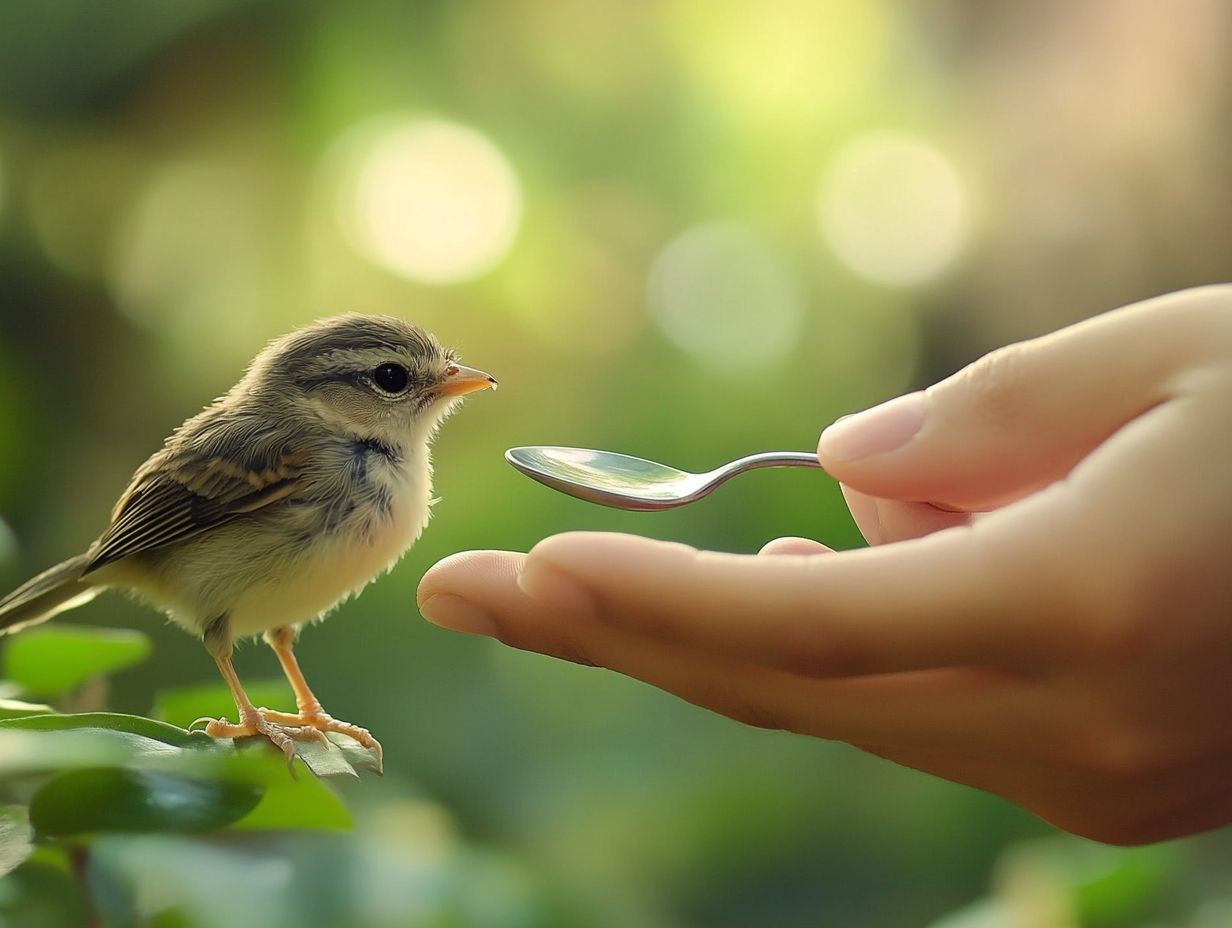
The frequency of feedings will depend on the age and species of the baby bird. Generally, they should be fed every 2-3 hours during the day. Older birds may only need to be fed every 4-6 hours.
Can I feed baby birds with a syringe?
Yes, a syringe can be a useful tool for feeding baby birds. Use one with a small tip and be very gentle to avoid any harm to the bird.
What should I do if a baby bird refuses to eat?
If a baby bird refuses to eat, it could signal an underlying health issue. Consult a wildlife rehabilitator or veterinarian for proper care and advice.
Do baby birds need water?
Yes, baby birds do need water, but not like adult birds. Offer a shallow dish of water for them to dip their beaks in, ensuring it’s shallow enough for them to stand in without the risk of drowning.
When should I start introducing solid food to baby birds?
Baby birds can start to be introduced to solid food when they are around 2 weeks old, depending on the species. Continue offering formula until the bird is fully weaned, which can take up to 6-8 weeks.
Ready to help our feathered friends? Start feeding with care today!


